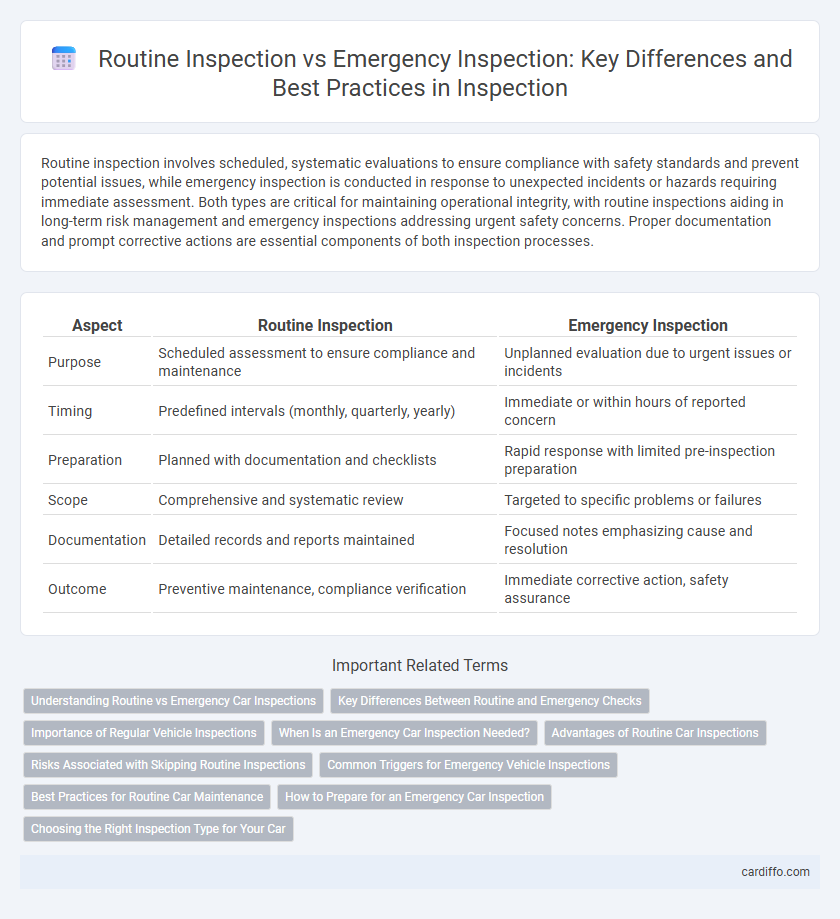Routine inspection involves scheduled, systematic evaluations to ensure compliance with safety standards and prevent potential issues, while emergency inspection is conducted in response to unexpected incidents or hazards requiring immediate assessment. Both types are critical for maintaining operational integrity, with routine inspections aiding in long-term risk management and emergency inspections addressing urgent safety concerns. Proper documentation and prompt corrective actions are essential components of both inspection processes.
Table of Comparison
| Aspect | Routine Inspection | Emergency Inspection |
|---|---|---|
| Purpose | Scheduled assessment to ensure compliance and maintenance | Unplanned evaluation due to urgent issues or incidents |
| Timing | Predefined intervals (monthly, quarterly, yearly) | Immediate or within hours of reported concern |
| Preparation | Planned with documentation and checklists | Rapid response with limited pre-inspection preparation |
| Scope | Comprehensive and systematic review | Targeted to specific problems or failures |
| Documentation | Detailed records and reports maintained | Focused notes emphasizing cause and resolution |
| Outcome | Preventive maintenance, compliance verification | Immediate corrective action, safety assurance |
Understanding Routine vs Emergency Car Inspections
Routine car inspections involve scheduled assessments to ensure vehicle safety, emissions compliance, and operational efficiency, typically performed at regular intervals defined by state or manufacturer guidelines. Emergency car inspections occur unexpectedly following accidents, breakdowns, or safety concerns, prioritizing immediate identification of critical issues to prevent further damage or hazards. Understanding the distinction helps vehicle owners prepare for maintenance, avoid penalties, and ensure roadworthiness under both planned and urgent circumstances.
Key Differences Between Routine and Emergency Checks
Routine inspections are scheduled evaluations focused on preventive maintenance and compliance verification, typically following standardized checklists to ensure ongoing safety and functionality. Emergency inspections occur unexpectedly in response to incidents or urgent risks, emphasizing immediate hazard identification and mitigation to prevent further damage or injury. Key differences include timing, purpose, scope, and the level of urgency, with emergency checks requiring rapid decision-making and often involving more detailed, situation-specific assessments.
Importance of Regular Vehicle Inspections
Regular vehicle inspections ensure optimal safety, identify mechanical issues before they escalate, and maintain compliance with road regulations. Routine inspections extend vehicle lifespan by addressing wear and tear proactively, reducing the risk of unexpected breakdowns. Emergency inspections are critical for diagnosing issues after incidents but cannot replace the preventative benefits of scheduled maintenance checks.
When Is an Emergency Car Inspection Needed?
Emergency car inspections are necessary when immediate safety concerns arise, such as after an accident, sudden mechanical failure, or when warning lights indicate critical issues. Routine inspections are scheduled periodically to ensure overall vehicle maintenance and compliance with regulations, but emergencies require prompt assessment to prevent further damage or potential hazards. Recognizing the signs that demand an emergency inspection can help drivers avoid accidents and costly repairs.
Advantages of Routine Car Inspections
Routine car inspections help identify potential vehicle issues early, reducing the risk of unexpected breakdowns and costly repairs. Regular inspections ensure compliance with safety regulations and enhance overall vehicle performance, contributing to safer road conditions. A consistent inspection schedule supports engine efficiency and extends the lifespan of critical car components.
Risks Associated with Skipping Routine Inspections
Skipping routine inspections significantly increases the risk of undetected equipment failures, leading to costly downtime and potential safety hazards. Emergency inspections often occur under pressure, resulting in incomplete assessments and higher chances of overlooking critical issues. Consistent routine inspections are essential to mitigate risks, ensure compliance, and enhance operational reliability.
Common Triggers for Emergency Vehicle Inspections
Emergency vehicle inspections are commonly triggered by incidents such as accidents, unexpected mechanical failures, or urgent safety concerns reported by operators. These inspections prioritize identifying critical issues that could compromise the vehicle's performance or passenger safety. Regular monitoring and strict adherence to maintenance standards help reduce the frequency of emergency inspections by addressing potential problems during routine checks.
Best Practices for Routine Car Maintenance
Routine car inspections involve scheduled checks of essential components such as brakes, tires, fluids, and engine performance to prevent unexpected failures. Best practices include following manufacturer-recommended maintenance intervals, using diagnostic tools for early detection of wear and tear, and keeping detailed service records. Emergency inspections, triggered by sudden issues like warning lights or unusual noises, require prompt diagnosis but should not replace regular routine inspections designed to maintain vehicle safety and reliability.
How to Prepare for an Emergency Car Inspection
Preparing for an emergency car inspection requires maintaining up-to-date documentation, including registration and insurance, and performing regular self-checks on critical systems like brakes, lights, and tires to ensure immediate compliance. Keep a checklist of essential vehicle components and have basic tools on hand to quickly address minor issues before the inspection. Familiarize yourself with local inspection criteria and have contact information for certified inspection centers to streamline the emergency process.
Choosing the Right Inspection Type for Your Car
Routine inspections ensure consistent vehicle safety by checking essential systems like brakes, tires, and lights at regular intervals, typically every 6 to 12 months. Emergency inspections address urgent issues such as sudden engine failure or unexpected warning lights and require immediate assessment to prevent accidents or further damage. Selecting the appropriate inspection type depends on your car's current condition and symptoms, with routine checks maintaining long-term reliability and emergency visits resolving critical problems swiftly.
Routine inspection vs emergency inspection Infographic

 cardiffo.com
cardiffo.com